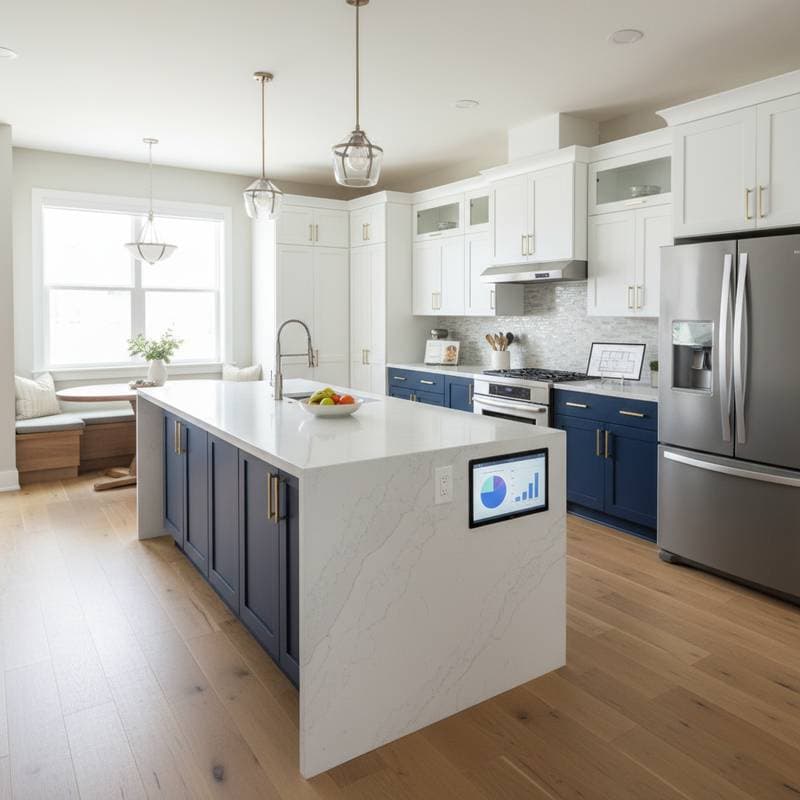Introduction to Kitchen Remodel ROI
Homeowners often view kitchen remodels as essential upgrades that enhance daily life and property value. Return on investment, or ROI, measures how much of the project cost recoups through increased home worth upon resale. Factors such as project type, budget allocation, and regional market trends influence these returns. This article examines various kitchen projects, their typical costs, expected ROI, and strategies to optimize outcomes. By understanding these elements, readers can make informed decisions that align with both immediate needs and long-term financial goals.
1. Cabinet Refacing for Cost-Effective Renewal
Cabinet refacing involves replacing doors, veneers, and hardware on existing cabinet boxes rather than full replacement. This approach suits kitchens with structurally sound cabinets, offering a fresh appearance without the expense of demolition and reinstallation. Professionals apply new skins to preserve the original framework, which reduces labor and material costs significantly.
Estimated Costs: $4,000 to $8,000 for a standard kitchen, varying by size and material choices like laminate or wood veneer.
ROI: Around 70 to 85 percent, as buyers appreciate updated aesthetics without suspecting underlying age.
Expert Insight: Select neutral finishes to appeal to broad tastes. Pair refacing with new hinges and pulls for seamless integration. This method extends cabinet life by another decade, providing practical value beyond resale.
2. Countertop Upgrades with Durable Materials
Countertops serve as a kitchen's workhorse, enduring heavy use while defining style. Popular options include quartz, granite, and butcher block, each balancing durability, maintenance, and visual appeal. Upgrading from outdated laminate to these materials elevates the space's perceived quality.
Estimated Costs: $2,000 to $6,000, depending on surface area and edge treatments; quartz offers mid-range pricing with low upkeep.
ROI: 65 to 80 percent, driven by the premium feel that signals a modern, high-function kitchen.
Expert Insight: Measure precisely to avoid seams that collect debris. Opt for heat-resistant materials in high-traffic areas. Consider integrated sinks for a streamlined look that simplifies cleaning and boosts efficiency.
3. Appliance Updates for Efficiency and Appeal
Modern appliances incorporate energy-saving features and sleek designs that transform kitchen performance. Focus on essentials like refrigerators, ranges, and dishwashers from reputable brands. Energy-efficient models qualify for rebates, further improving financial returns.
Estimated Costs: $3,000 to $10,000, with budget options in stainless steel starting under $5,000 total.
ROI: 60 to 75 percent, as functional upgrades demonstrate reliability to potential buyers.
Expert Insight: Prioritize ENERGY STAR-rated units to lower utility bills. Ensure proper ventilation for gas ranges to maintain safety. Stainless finishes unify the space, creating a cohesive, professional atmosphere.
4. Lighting Enhancements for Functionality and Ambiance
Effective lighting illuminates tasks, highlights features, and sets mood. Combine recessed cans for general illumination, pendants over islands for focused light, and under-cabinet strips for precision work. LED options provide longevity and dimming capabilities.
Estimated Costs: $1,000 to $4,000, including fixtures and wiring updates.
ROI: 75 to 90 percent, since well-lit kitchens feel larger and more inviting.
Expert Insight: Layer lighting types to accommodate various activities. Install dimmers for versatility in entertaining or family meals. Warm bulbs mimic natural light, enhancing food preparation accuracy.
5. Minor Layout Adjustments for Better Flow
Significant changes do not always require structural overhauls. Relocating an island, adding a pass-through, or repositioning appliances can streamline movement without major disruption. These tweaks address inefficiencies like cramped corners or awkward traffic patterns.
Estimated Costs: $5,000 to $15,000, influenced by necessary plumbing or electrical modifications.
ROI: 70 to 80 percent, especially when combined with surface-level cosmetics.
Expert Insight: Optimize the work triangle connecting sink, stove, and refrigerator. Aim for distances of four to nine feet between each point to facilitate efficient cooking. Ensure at least 36 inches of clearance for walkways to promote safety and ease.
Strategies for Budget-Conscious Remodels
Budgets shape project scope, with minor updates yielding higher ROI percentages than extensive overhauls. Allocate funds to high-impact areas like visible surfaces over hidden infrastructure unless functionality demands otherwise. Phased approaches allow gradual investment, testing preferences before committing more.
For budgets under $10,000, target cosmetic refreshes that refresh without reconfiguring. Mid-range plans from $10,000 to $25,000 support combined updates like countertops and appliances. Larger budgets exceeding $25,000 enable layout changes and custom elements, though ROI may dip below 60 percent due to personalization risks.
High-ROI Quick Wins:
- Apply fresh paint in enduring neutral tones to walls and ceilings.
- Swap outdated faucets and sinks for durable stainless steel versions.
- Install a protective tile backsplash to simplify maintenance.
- Update cabinet hardware and add LED under-cabinet lighting for illumination.
These interventions often finish in a weekend for around $2,000, delivering outsized visual and practical benefits.
Preserving Remodel Value Through Maintenance
Sustained care protects investments and sustains appeal. Use gentle, pH-neutral cleaners on quartz or tile to preserve shine and resist etching. Schedule annual grout resealing to block stains and moisture penetration.
Inspect caulk around sinks and backsplashes quarterly, replacing deteriorated sections promptly. For refinished cabinets, employ microfiber cloths with diluted soap solutions to avoid finish degradation. Routine appliance filter cleaning ensures optimal performance and energy savings.
Diligent upkeep not only extends material lifespan but also maintains the kitchen's market competitiveness over years.
Integrating Design into Daily Life
A successful remodel enhances routines, from effortless meal prep to relaxed gatherings. Improved layouts reduce physical strain, encouraging more home cooking. Thoughtful lighting eases evening tasks, fostering comfort throughout the day.
Apply ROI principles to future decisions by weighing personal utility against resale potential. Select enduring materials and versatile layouts that serve multiple generations. This balanced approach ensures the kitchen remains a valued asset, both in use and upon sale.
